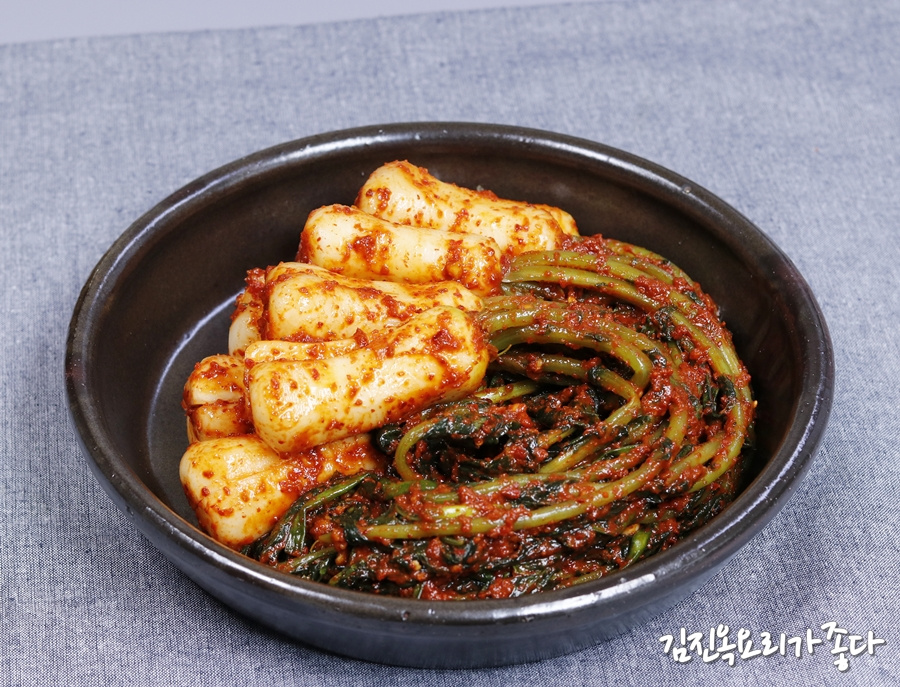Chonggak Kimchi (Ponytail Radish Kimchi)
Easy and Delicious Chonggak Kimchi Recipe Without Glutinous Rice Paste

This recipe offers a simple yet incredibly flavorful way to make Chonggak Kimchi (also known as Altab Kimchi or Ponytail Radish Kimchi) without using glutinous rice paste. Enjoy the satisfying crunch and deep, refreshing taste of homemade kimchi!
Chonggak Kimchi Ingredients (Spoon measurements)- 2 bundles of Chonggak Radishes (approx. 2kg per bundle)
- 200g Scallions (about 2 handfuls)
- 6 Red Chilies
- 1/2 Onion (approx. 150g)
- 1 stalk of Leek (white part only)
- 1 pouch of Pear Juice (100ml)
- 4 Tbsp cooked rice (approx. 70g)
- 2 Tbsp salted shrimp (approx. 40g)
- 100ml Fish Sauce (anchovy)
- 180ml Anchovy-Kelp Broth
- 4 Tbsp minced garlic (approx. 80g)
- 2 Tbsp plum extract (or sugar)
- 400ml Gochugaru (Korean chili flakes)
- 1 Tbsp Salt (for seasoning)
For Brining- 200ml Coarse Sea Salt (Sun-dried salt)
- 500ml Water
- 200ml Coarse Sea Salt (Sun-dried salt)
- 500ml Water
Cooking Instructions
Step 1
Start by preparing the 2 bundles of Chonggak radishes. Each bundle weighs approximately 2kg. Remove any yellowed or dirty outer leaves. Trim the root end of the radishes and slightly cut where the radish meets the greens. Scrape off any dirt from the surface of the radish. If the radishes are small, you can use them whole; if they are large, cut them into 2-4 pieces. A helpful tip is to wash the radishes thoroughly with a scrub brush first, which makes removing dirt and trimming much easier, often eliminating the need for scraping.

Step 2
Rinse the prepared Chonggak radishes thoroughly under running water to remove any remaining dirt or debris.

Step 3
Now, it’s time to brine the radishes. In a large bowl, combine 200ml of coarse sea salt and 500ml of water. Spread the radishes in your brining container or a large bowl, sprinkling coarse salt between layers. Repeat this process, adding more radishes and salt. Finally, dissolve the remaining coarse salt in 500ml of water and pour it evenly over the radishes. In the current weather, brine for about 1 hour to 1 hour and 20 minutes, turning them halfway through to ensure even salting. ***It’s important to note that the brining time isn’t fixed; adjust it based on the size of the radishes and the ambient temperature. The radishes are ready when they become pliable and bend easily.

Step 4
While the radishes are brining, let’s prepare the seasoning paste. In a blender, add half an onion, the white part of one leek, and 6 red chilies (seeds removed), cut into manageable pieces.

Step 5
Add 2 Tbsp salted shrimp, 4 Tbsp cooked rice, 180ml anchovy-kelp broth, 1 pouch (100ml) pear juice, and 100ml fish sauce to the blender. Blend until smooth. ***You can substitute cana-li fish sauce for anchovy fish sauce if preferred.

Step 6
Pour the blended mixture into a bowl. Add 4 Tbsp minced garlic, 1/2 Tbsp minced ginger, 2 Tbsp plum extract (or sugar), 1 Tbsp salt, and 400ml gochugaru. Mix everything thoroughly to create the seasoning paste. It’s best to season slightly lightly at first and adjust the saltiness later after mixing. If you don’t have pear juice, you can add about 1/4 of a pear, cut into pieces, to the blender for a similar sweet and refreshing flavor.

Step 7
Wash the 200g of scallions (about 2 handfuls) intended for garnish and cut them into large pieces.

Step 8
Once the radishes are well-brined, rinse them two to three times under running water to remove excess salt. Drain them in a colander for at least 15 minutes. Properly draining the water is crucial to prevent the kimchi from becoming mushy and ensure good fermentation.

Step 9
In a large bowl or kimchi container, combine the drained radishes, prepared scallions, and the seasoning paste. Mix well, ensuring the paste coats every radish and gets into the crevices. If you have leftover paste, it’s perfect for making other kimchi dishes like Pajeori (green onion kimchi) or Kkakdugi (cubed radish kimchi). Place the mixed kimchi in a kimchi container. Let it ferment at room temperature for one to two days, then store it in the refrigerator. As the temperature rises above 30°C (86°F) in mid-May, the radishes can become spicier, so it’s a great time to make this kimchi before it gets too hot. If your kimchi turns out too salty, you can add more radish pieces in between layers to absorb some salt. If it’s too bland, drizzle a small amount of fish sauce evenly over the kimchi. If you have extra seasoning paste, it can be used for other delicious kimchi like green onion kimchi, fresh kimchi salad (geotjeori), or cubed radish kimchi (kkakdugi).

Step 10
Today is Labor Day! Wishing all the hard-working individuals in Korea a happy and joyful day. May the beginning of May be filled with wonderful things!




